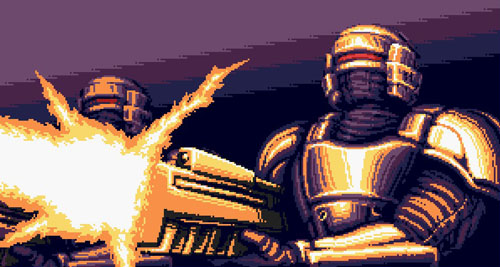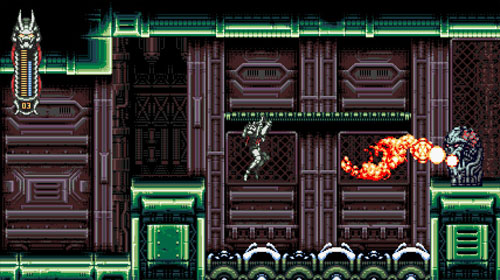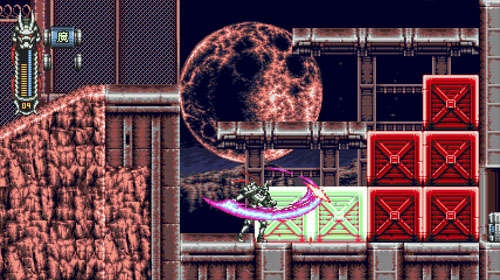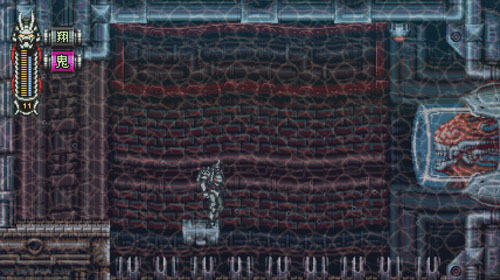A game by Joymasher for PC, Switch, PS4, and PS5, originally released in 2023.
Vengeful Guardian: Moonrider is a sidescrolling slasher inspired by 16-bit genre entries like Hagane and the Shinobi series. You take on the role of Moonrider, a ninja-like bioweapon created by the scientists of a totalitarian state, with the sole purpose of obliterating anyone with the gall to rise up against them. However, you have managed to override your programming and decide to fight against the very system that created you, acting as a defender of the people and a sword of vengeance against the authoritarian regime and its instruments of power.Ultimately, the story doesn’t do much more than establish a framework wherein you slash the absolute bejeezus out of every moving object in your visual range. And of course, there’s plenty of pre-fight posturing by the other guardians you encounter as they decry your actions and promise to put you down once and for all… giving you plenty of reason to cleave them in twain before moving on to your next target.
Visually and aurally, the game is stunning. These days, there are plenty of 2D actioners that set out recreate the fondly-remembered days of the 8- and 16-bit eras, but few games pack this level of authenticity. Sprites are detailed while retaining a reduced color palette, characters and environments have unifying themes while offering a decent amount of variety, and bosses are menacing, powerful, and often grotesque, acting as setpiece moments throughout the experience. All of this is backed up by a wailing soundtrack fit for rendering some scary effing cybermonsters into wondrous sprays of sanguine fluid.
An optional tutorial is available via the main menu, which is worthwhile as it explains a some combat and navigation nuances. You have a highly variable 2x jump, the ability to perform wall jumps with the proper timing, and a slow walking speed (similar to Shinobi or Hagane)… but you also have a RUN button that lets you zip quickly through the environment. While standing, you have a 3-hit melee combo, and you can perform a 1-hit strike while ducking or jumping, and your strikes also absorb enemy projectiles. Pressing DOWN+ATTACK while jumping allows you to perform a downward or downward-angled kick, which flings you upward when you hit an enemy.
In addition, you have a special weapon called a moonspear, which draws energy from a secondary meter. This weapon deals damage at a slightly longer range but also delivers continuous damage, often letting you get in a couple of hits on an enemy as it extends and retracts. There are six other special weapons to unlock, each of which is gained by defeating a boss, and these often mimic the abilities of the defeated boss, Mega Man-style. These weapons include a spray of projectiles, flaming boomerangs, and even an extending tentacle that emerges from a dark portal… and does loads of continuous damage with its long range.
Another powerful ability – which is explained but is perhaps somewhat less obvious – comes in the form of a running slash. By attacking while running, the moonrider lunges forward and performs a wide sword slash, after which he stands motionless during an extended cooldown period, leaving him open to attack. Players may view this as a vulnerability and opt to stick with their 3-hit combo to deal repeated damage to enemies. However, the slash is actually an advanced technique, as it does significantly more damage, wiping out most enemies in a single hit.
The key to the running slash is timing… by attacking at just the right moment, it’s possible to take out some threatening targets before they have the opportunity to unleash even a single attack, but you’ll be left holding your mechanical Johnson if you attack too early or too late. By mastering this technique, you can actually run at full speed through many levels, wiping out swaths of enemies in mere seconds instead of standing to fight them with your standard combos. This method can also help you to earn a better rank at the end of the level (if that’s your bag), and it can speed things along when you replay levels looking for hidden upgrades.
Hidden in most levels are one or two computer chips that grant you new abilities, including health and energy regeneration, a double jump and air dash, and a powerup that increases your strength as you defeat enemies. There’s even one that makes the game more difficult by enabling 1-hit kills for the player, falling more in line with classic games. These chips are usually found well off the beaten path or behind destructible walls, and getting to them often requires advanced techniques, such as performing multiple wall jumps in succession, or leaping between a series of moving or crumbling platforms. You can equip two chips at a time, and these are selected between missions (although you can immediately equip a chip as soon as you find it).
These powerups help players tailor gameplay to suit their strengths, and also help to make the experience more forgiving than many of the 16-bit games that inspired it. While you can’t absorb many hits before being killed, the game is generous with its health and energy drops, allowing you to sustain a fair amount of damage and still make progress. Checkpoints are spread out a bit, and may require a fair amount of repeated gameplay, but they’re more frequent than those found in older games, and there’s always a checkpoint right before the end-level boss. There are also 1UPs to be found, often by exploring side paths, and if you do manage to lose all of your lives, you are rewarded with an armor chip that reduces the amount of damage you take when hit.
Further adding to the game’s forgiving nature is that most levels can be played in any order. Once you complete the first level, the next six may be selected from a menu, and you can revisit completed levels at any time to search for powerups or just to stock up on some 1UPs. Once the first seven levels are completed, the eighth and final level is unlocked. While some levels are certainly more challenging than others, the ability to select between them means you can exit at any time and try another, and you’re not forced into an ever-escalating difficulty.
Some levels play out as generally left-to-right affairs, with a few side paths or short alternate routes to be found, but things are changed up frequently throughout the adventure with some wide open levels that offer lots of exploration and some backtracking, the occasional forced-scrolling sequence, some levels where you jump between moving or flying vehilces, and an ascent-based challenge where you climb a vertical shaft while trying to outrun rising flames… a staple of many genre classics that’s almost as common as the elevator sequence (which, yeah, that's in here too).
Combat is the primary gameplay element, although there are some challenging platforming segments here and there… and you’ll need to get used to the moonrider’s high jumps that scroll the ground out of view, making it more difficult to line up your landings. There are also a couple of over-the-shoulder motorcycle driving sequences, which are nice change of pace but ultimately fairly simple compared to the rest of the experience, with a lot of basic enemies, a few wide open stretches of nothing, and some basic miniboss encounters.
There are some extended subaquatic sequences as well, where you move more slowly but jump much higher, as is traditional. Here, you transition in and out of the water as you face different sorts of hazards and enemies, but you also need to raise and lower water levels and hunt for the path that leads you forward. This area even features some underwater miniboss fights.
There’s a decent variety of enemies, ensuring that players must employ a bit of strategy when fighting through the levels, with a few enemy types being reused throughout the game. There are some shielded enemies that can only be damaged when they attempt to strike, flying enemies that fire projectiles, snipers that target you from a distance (telegraphed by the appearance of a red laser), and some brutes that require a lot of hits to take down. Enemies are mostly biomechanical, with some featuring menacing-looking designs, and many offering satisfying death animations as they are sliced with your blade.
There are even a few fakeouts where you face off against a miniboss, thinking you’re near the end of the level, only to discover that you still have another miniboss and boss to face before you reach the end. Miniboss fights tend to be fairly straightforward, generally cycling through a couple of attack and movement patterns… but they don’t have health meters, so it can sometimes be difficult to tell how you’re faring in the fight.
As mentioned, boss (and miniboss) encounters are the big setpiece moments, with some spectacular biomechanical creature designs. Bosses have a wider array of moves than minibosses and are pretty good about telegraphing their attacks, so veteran players will likely find these encounters easy to manage. And, given the right powerup chips, most minibosses and some bosses can be overcome with brute force… simply standing in front of them wailing away with attacks and special attacks, which is a bit disappointing given how much buildup there is to these moments.
2D CRED
Blazing Chrome was developed by Joymasher, a studio founded in 2012 by Danilo Dias, Thais Weiller, and Marco Galvão, and based in Sao Paulo, Brazil. The studio previously developed Oniken, Odallus: The Dark Call, and Blazing Chrome, each of which took inspirations from 8- and 16-bit console classics.
The game was developed in partnership with Asteristic Game Studio, which previously developed Dreaming Sarah and Dandy & Randy.
The game was published by The Arcade Crew, which previously published Dark Devotion, Blazing Chrome, and Kunai.






























0 comments:
Post a Comment